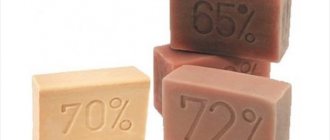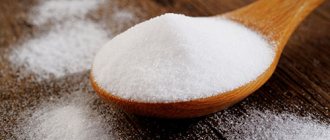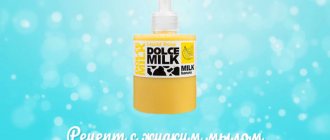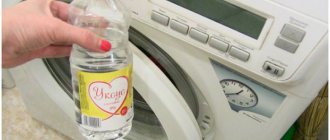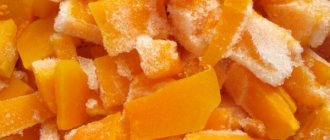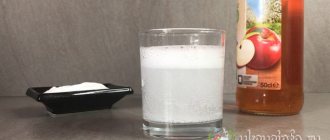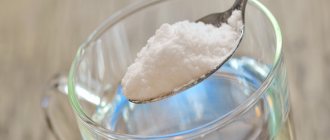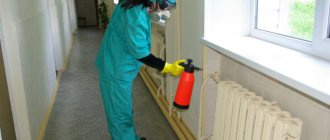There are hundreds and even thousands of products designed to disinfect premises. Some manufacturers do not focus on the composition, but most assure that the chemicals are safe. Making sure that a product actually does not cause harm is often quite difficult. Therefore, many do not risk using chemicals to treat premises. Especially if children live in the apartment. A soap and soda solution would be an excellent alternative. You can cook it yourself. To do this, you will need regular baking soda and laundry soap.
sodaved.ru
Properties
The chemical properties of soap and soda make it possible to use the solution for household and cosmetic purposes, as well as in folk medicine.
Useful properties of the solution:
- Has an antiseptic, antibacterial effect.
- Copes well with pathogenic microflora, infections, fungi.
- Cleans various contaminants without destroying the structure and pigment of the material.
- In cosmetic procedures it is used to remove dead particles of the epidermis, soften the skin, and accelerate renewal processes.
- Has hypoallergenic properties.
Read more: Properties and formula of baking soda.
Does baking soda disinfect?
There are 3 types of soda: drinking soda (baking soda), soda ash (laundry soda) and caustic soda (caustic soda). Their chemical composition differs. All have an alkaline pH, but at different rates. Therefore, soda disinfects with varying degrees of activity.
Baking soda is white powdered sodium bicarbonate. In a 1% solution the pH is 8.5. At other concentrations the indicator fluctuates slightly. Weak solutions have a pronounced antacid property. They reduce stomach acidity, which leads to a decrease in the Helicobacter pylori population.
Properties of baking soda for external use:
- weak antiseptic - slowly destroys pyogenic bacteria;
- bacteriostatic - disrupts the vital activity of all infections, worsening their living conditions; when rinsing, it suppresses pathogens of conjunctivitis, sore throat, pharyngitis, stomatitis, pathologies of teeth and gums;
- damages the lipid membranes of pathogens, including coronavirus (slow action);
- disinfectant - soda disinfects surfaces from yeast fungi, fermentation bacteria, intestinal infections and microbes that cause food spoilage;
- deodorizing - soda cleans surfaces, destroys microbes and decomposes substances that cause the smell of rot, urine, animal marks and other reasons.
Soda ash is white powdered sodium carbonate. In a 1% solution the pH is 11.6. Its effect is not much stronger than baking soda. The product is suitable for washing, disinfecting dishes and toys. It has bacteriostatic, antiseptic and deodorizing properties.
Caustic soda (caustic) is granular, liquid or powdered sodium hydroxide. In a 1% solution the pH is 13.4. It is not advisable to disinfect metal products.
Of the three types of substances, caustic disinfects best. It is also suitable for garden disinfestation, disinfestation, and spore destruction.
Caustic soda destroys pathogens:
- epizootic lymphangitis;
- anthrax;
- glanders;
- brucellosis;
- plague;
- campylobacteriosis;
- pasteurellosis;
- listeriosis;
- leptospirosis;
- bird flu;
- rabies;
- foot and mouth disease;
- Aueszky's disease;
- infectious rhinitis, erysipelas and gastroenteritis of pigs, enterotoxemia of sheep, influenza, anemia, equine encephalomyelitis;
- ascariasis, heterokidiasis, parascariasis, toxocariasis, trichuriasis, other parasitic infections of domestic animals or animals.
Caustic is used in everyday life and for treating areas where animals are kept and other sanitary inspection facilities.
Caustic is disinfected with strict adherence to precautions: the composition leaves chemical burns on the skin and can irreversibly damage the eyes.
Ingredients
Classic solution recipes use sodium bicarbonate and laundry soap. The latter can be purchased with different percentages of acids (indicated on the bar). Laundry soap is also available in liquid form. In category 1 soap, with a content of 72%, maximum acidity and the absence of any organic odors are implied. Categories 2 and 3, 70% and 65%, use rosin and synthetic fatty acids.
Figure 1 - laundry soap of categories 1, 2 and 3.
Why are mercury vapors dangerous?
Mercury vapor formed as a result of damage to the device - its source - is a serious threat to the human body.
Since this metal has a silvery-white color and no odor, it is almost impossible to determine its presence in the room. At the same time, the symptoms of poisoning will intensify with each passing hour, which can lead to multiple organ failure (MOF - simultaneous or sequential destruction of the functions of several organs at once), damage to the central nervous system and even death.
Disinfection solution
To prepare a solution for disinfection:
- Grate 50 gr. laundry soap.
- Dissolve soap in 1 liter. hot water.
- Add 200 gr. soda, stir thoroughly.
- Dilute the finished concentrate with 9 liters of water.
- Disinfection should be carried out once a day. After treatment, it is advisable to ventilate the room.
- After treatment, wipe the surface dry.
The prepared solution is used to treat floors, tiles, plastic products, and plastic toys.
How to make soap from soap remnants
It is almost impossible to use solid soap completely. The bar is gradually washed away and turns into one or several tiny pieces that are uncomfortable to hold in your hands. Such remnants can be thrown away or given a “second life”, for example, turned into a new bar of soap.
You can make soap from soap remnants using simple tools that are accessible to everyone. For this you will need:
- remnants of solid soap;
- hot water;
- grater;
- container for soap base;
- pot;
- spoon for mixing soap mass;
- molds for bars.
These can be special molds for soap making, or more affordable silicone baking molds. Some children's toys or small food containers are also suitable for this purpose.
How to Make Soap from Remnants: Pexels
Preparing the soap base
The first stage of preparing a homemade hygiene product is preparing the soap base. To create it, you need to grate the existing soap on a grater. This is the easiest way to grind raw materials.
You can use a knife to prepare the soap. However, you need to cut the pieces very finely (large ones will take longer to dissolve). Therefore, the grinding procedure may take a little longer.
The finished soap crumbs must be dissolved. To do this, pour 200 g of crushed soap into a glass of hot water and leave for two hours. Use milk as a “solvent”. In this case, a ready-made hygiene product will be more useful.
If desired, you can prepare solid soap from soap remnants with glycerin, lemon zest, herbal infusions, essential oils, and floral fragrances. Such components will improve the composition of the soap, its aroma and cosmetic properties. You can add such ingredients to the soap mass both at the stage of dissolving the soap mass and during its further preparation.
How to make soap from leftover soap, further enhancing your cosmetics? For example, you can add activated carbon as an ingredient. This soap is ideal for caring for oily skin.
How to make solid soap
When the soap mass has infused a little, start preparing the future soap. This process consists of a few simple steps:
- Place the pan with the soap base on the fire or organize a water bath for it.
- Mix the existing mass thoroughly during heating.
- Remove foam from the surface if it appears.
- Wait until all the soap shavings turn into a homogeneous substance.
- Add glycerin, essential oils and other ingredients, mix thoroughly again.
- Lubricate the molds for future soap with vegetable or olive oil.
- Pour the substance into prepared molds and leave to harden for 1-2 hours at room temperature.
After hardening, homemade soap is completely ready for use.
Important cooking tips
When colorful remnants accumulate, housewives do not know what to do with them. Some believe that it will no longer be possible to make soap from such pieces due to the different composition and shade.
Actually this is not true. In the process of preparing homemade soap base, the available material is thoroughly mixed. Its color will be uneven, but this will not affect the quality of the finished bar.
When making homemade soap, it is important to consider a few more points:
- When cooking the base, an unpleasant odor is often released. Do not add too many fragrances or essential oils because of this. Limit yourself to 10-12 drops. When the finished bars cool, the smell of the soap will change.
- If you add natural ingredients to the soap (for example, milk or orange zest), the shelf life of the hygiene product is reduced. You need to use this soap faster than usual.
- You can make the resulting soap solution thicker with sugar. For this, 20 g of sweet additive is enough.
- Do not use chemical dyes in the process of making homemade soap. It is better to replace them with food or natural ones.
This could be beet juice, saffron, calendula, coffee, hibiscus or cocoa solution. By using these ingredients, you will get not only a beautiful, but also a useful hygiene product.
Dishwashing solution
To make the solution in a stainless steel or enamel bowl (Figure 2), follow the following recipe:
- grate a whole bar of soap 72% (100 g)
- add it to 2 liters of boiling water;
- then remove from heat. Pour 6 tbsp into the still warm liquid. spoons of sodium bicarbonate;
- mix thoroughly. Pour the prepared solution into a tightly sealed jar.
To clean a 5 liter pan, just 1 tbsp will be enough. spoons of detergent.
Figure 2 - preparing a soap-soda solution in an enamel pan.
To make a solution in a ceramic or glass container, use the following recipe:
- For 500 ml of water, take 30 ml of liquid laundry soap, 2 tbsp. spoons of soda and 1 tbsp. a spoonful of mustard powder;
- Mix all ingredients. Pour the product into an empty dispenser bottle;
- Shake well until foam appears.
The video describes how to quickly prepare safe dishwashing detergent. A product made at home also allows you to reduce the cost of household chemicals.
Demercurization
A broken thermometer causes panic. And the problem is not the loss of a medical device. The excitement is caused by the understanding of the danger of the substance contained inside.
Expert opinion
Carefully!
Mercury is characterized by toxicity. The excretory system and nervous activity are most at risk. Volatile vapors enter the body with inhaled air. In case of severe poisoning, death occurs.
A frightening prospect can be avoided with basic correct actions:
- clear the room of children and animals;
- isolate from the rest of the room (close the door / curtain the doorway with a blanket);
- moisten a cloth in a solution based on potassium permanganate (1 gram of potassium permanganate is required per 500 milliliters of water);
- put on the threshold (will prevent the transfer of small particles of the substance to shoes and feet);
- ventilate the room (lowering the ambient temperature will slow down the evaporation process);
- minimize contact of mercury with the respiratory tract, skin of the hands and feet (use polyethylene, gloves, gauze bandages and other protection options; the fabric is pre-moistened in a solution of potassium permanganate);
- collect mercury and fragments in a container with water (adhesive tape and a syringe will make the task easier);
- carry out cleaning using manganese;
- After an hour, repeat the procedure with soap and soda;
- Carry out this double treatment for the next 3 days.
The soap composition with baking soda is prepared as follows:
- water is poured into the container;
- NaHCO3 and grated soap are added (proportions are 50 and 40 grams per 1 liter of liquid, respectively);
- achieve homogeneity by thoroughly mixing.
Fungus treatment
A soap-soda solution is used at the early stage of the disease. The product allows you to get rid of unpleasant odor, itching and flaking, and restore the integrity of the skin.
Solution recipe:
- Pour 3-6 liters of water into a clean basin, add 20 g. soap shavings or the same amount of liquid laundry soap;
- add 30 gr. soda You can use 4-5 drops of tea tree oil to enhance the healing effect;
- Immerse your feet or hands in the bath.
For sensitive skin, use category III laundry soap (64%).
The procedure lasts 10 minutes. This should be repeated every evening after basic hygiene procedures. Treatment will take from several weeks to 6 months, depending on the area of the lesion.
Read more: Foot baths with soda for fungus.
Symptoms of poisoning
The first signs indicating intoxication of the body:
- metallic taste in the mouth;
- lack of appetite;
- nausea and vomiting;
- headache;
- pain when trying to swallow;
- general weakness;
- increased secretion of saliva;
- swelling and bleeding of the gums.
Over time, a person may develop the following severe symptoms:
- severe pain in the abdominal area;
- watery stools containing blood and mucus;
- shortness of breath and cough;
- chest pain;
- fever;
- elevated body temperature: 38–40 °C.
As a result of a medical test, mercury is found in the urine of a poisoned person.
Dangerous concentration
Long-term interaction with mercury vapor, even in relatively small doses of hundredths and thousandths of mg/m3, leads to damage to the central nervous system.
- Concentrations in the range: 0.001–0.005 mg/m3 provoke the development of severe chronic diseases.
- Acute poisoning threatens from 0.13 to 0.80 mg/m3.
- Lethal outcome occurs when inhaling 2.5 g of mercury metal vapor.
Reference. The maximum permissible concentration (MAC) is considered to be 0.0003 mg/m3.
Wash
A soap-soda solution is well suited for removing stains of any complexity. Its main advantage is hypoallergenicity. The solution is suitable for washing clothes for babies and people with skin diseases. It can be used for any items, including delicate items made of silk and wool.
Recipe for soap and soda solution for washing:
- 10 gr. stir soda in 50 ml of warm water;
- add 40 gr. grated soap;
- After stirring well, add the product to the water.
The volume of the prepared product is enough to wash 3-4 kg of clothes.
The advantage of a proven product
The main advantage of a solution of laundry soap and soda is its safety. Anyone can prepare a cleaning mixture, and washing the floor or kitchen using natural ingredients will not cause harm to health. Sometimes the abundance of washing gels, powders and emulsions forces a person to purchase them for everyday needs, however, few people think about the hidden danger.
It is much better to remember what people used several decades ago and try to use the studied and simple remedy in everyday life.
SANPIN rules
The sanitary and epidemiological standards developed for preschool institutions, hospitals, and clinics provide instructions for the preparation and use of the solution.
Use of the product according to SanPiN:
- in preschool institutions, a 2% solution is used twice a day to treat toys, clean surfaces, carry out wet cleaning, and clean furniture;
- in inpatient departments and clinics, soap and soda solution is used for daily and general cleaning of premises and equipment;
- according to the instructions, a 1% solution is used for cleaning floors; a 2% solution is used for treating toys and furniture in kindergartens;
- For general cleaning, regardless of the purpose of the room, only a 2% solution is used.
Preparation
To make a classic soap-soda composition, you will need laundry soap, baking soda or soda ash, and water. Since soap is now sold not only in solid but also in liquid form, the recipe will be different. The saturation of the solution is also different and depends on the purpose of its use. Liquid soap usually contains a large amount of fragrance, so it is better to take a standard 72% solid bar.
Recipe for preparing a 10% solution
Grate soap
In a situation where you need to process a large room or a number of objects, it is easier to prepare a saturated composition, which can then be diluted with water in the required proportions. This is exactly what they do in health care facilities and kindergartens.
- Grind 500 grams of laundry soap on a grater. It is best to take 72%, since the bar with a lower percentage uses rosin and synthetic fatty acids for production. Dilute the resulting shavings in 2 liters of water and cook until smooth, remembering to stir.
- Add 500 grams of soda to the soap solution and increase the amount of water to 10 liters. Boil the resulting liquid. Leave the mixture to steep until it thickens.
To prepare a 1% soap-soda solution, take 50 grams of a 10% mixture and dilute it in 5 liters of clean water. The two percent composition is prepared in the same way, only the amount of the mixture is doubled. One hundred grams of 10% liquid is diluted with 5 liters of water.
Important! You can get a 10% soap-soda composition in another way. Laundry soap is dissolved in one container, and soda in another, then they are poured together by adding water so that the total volume is 10 liters.
Soap and soda solution for disinfection
An alkaline environment is harmful to pathogenic bacteria. For disinfection, a soap-soda solution is used during epidemics of acute respiratory viral infections and other infectious diseases. It is necessary to treat the room with this composition every day, especially if there are sick people in the house.
Attention ! The prepared composition is not intended for long-term storage. It must be used on the same day it was prepared.
For disinfection, as a rule, a 2% solution is used. It is obtained either by diluting a 10% solution, or the required concentration is prepared immediately. To prepare it take:
- 5 liters of hot water;
- 100 grams of soap;
- 100 grams of baking soda.
Baking soda can be replaced with soda ash. To clean objects from germs, they are soaked in the composition for 30–45 minutes, then washed in running water. Furniture and walls are wiped with a rag soaked in the solution. They also wash floors, plumbing fixtures, and tiles. To enhance antibacterial protection, you can drop an aromatic oil with a citrus or pine scent into the solution.
Cleaning the room should begin by soaking all small items to be processed, with the exception of soft toys. The linen used by the patient is soaked separately. Next, furniture, walls, doors, and air conditioning are treated. Washing the floor. After the final rinsing of the soaked items, the plumbing fixtures are thoroughly treated.
Anti-mercury treatment of the room
What not to do if a thermometer breaks
A thermometer that breaks at home can bring a lot of trouble, so the room must be immediately treated with a soap-soda solution, which should be prepared in the following proportions:
- 30 grams of soap;
- 30 grams of soda;
- 1 liter of water.
First of all, you need to open the windows and remove children and pets from the room. Before treating a room, you need to put on clothes that you won’t mind throwing away later. Continued use of it will be harmful to health, and washing in a machine will lead to contamination of the device.
Collect spilled mercury with a syringe or syringe without a needle and place in a tightly closed container. Hand over this container to a special recycling service.
Attention ! Remaining mercury from the thermometer should not be thrown into the garbage chute or garbage cans. The fumes from this substance are hazardous to health.
The floor in the room where the thermometer was broken should be thoroughly washed with soap and soda solution. Pay special attention to cracks and areas under baseboards. The rags used for processing should also be thrown away.
Ready solutions for disinfection
Preparing working solutions for disinfecting instruments in medicine, beauty salons, and hairdressing salons is not always convenient. In these cases, they prefer to use purchased funds.
- Alaminol solution for disinfecting instruments is used mainly in beauty salons. Disinfection of manicure instruments is a mandatory procedure that guarantees safety for both the master and the client. Before diluting alaminol for disinfection, you need to look at the concentration of the substance, which is indicated on the packaging. A solution above 8% destroys not only bacteria and viruses, but also fungal infections. A weaker concentration is suitable for treating work surfaces.
- Beauty salons and medical institutions often use the Russian product Estilodez concentrate. How to dilute to disinfect instruments is detailed in the instructions. The kit also includes special test strips for determining the concentration of the solution. This drug does not cause corrosive effects on metal, does not contain sodium hypochlorite, and actively fights the bacteria of tuberculosis, hepatitis, herpes, HIV, and pathogenic fungi. Tools, towels, napkins and work surfaces can be treated with Estilodez.
- Chloramine B is used in kindergartens, catering establishments, medical institutions, hotels and other public institutions in order to disinfect premises during cleaning. Well suited for processing non-metallic tools. To prepare, just dilute the powder in warm water. Belongs to hazard class 3, low toxicity. Widely used in dentistry, but cannot be used as a disinfectant material for impressions.
We must not forget that in high concentrations these products are quite caustic, so when using you need to use rubber gloves, and you can only remove tools from the solution with special tweezers.
Precautionary measures
Rules for the safe use of soap and soda solution.
- To clean various surfaces, wash, and handle toys, be sure to wear rubber gloves;
- after cosmetic baths, you need to rinse your feet and hands under running water, wipe dry and apply cream;
- processed fruits, vegetables, toys should also be thoroughly rinsed with water and dried with a towel.
Soap and soda solution continues to be a leader among household cleaners and disinfectants. This is a universal tool for solving many problems and significant budget savings.
Alternative formulation
A one- and two-percent soda-soap solution can be obtained without preparing a highly concentrated base, which must subsequently be diluted. However, this method is more suitable for domestic needs, since in institutions the compositions are prepared on a 10% basis.
A one percent solution is obtained by diluting grated laundry soap and soda ash, taken 100 grams each, in 10 liters of water. If a smaller amount of disinfectant is needed, then the proportions are halved.
A two percent solution is prepared by increasing the dosage of each component by two, that is, taking 200 grams each, but for the same amount of liquid. This also applies to reducing the proportions, when 100 grams of both soda and laundry soap are added to 5 liters of water.
It is necessary to prepare both products according to this recipe only before direct use. This disinfectant composition cannot be stored. It is used for its intended purpose and poured out.
